Teepee Garden Ideas: Creative Tips for a Cozy Outdoor Space
Gardening can be both fun and rewarding, and incorporating creative structures like teepees can make your garden even more exciting. Teepee garden ideas are perfect for maximizing space and adding a unique touch to your green space. Whether you have a small patio or a large backyard, these ideas can fit perfectly into any garden size.
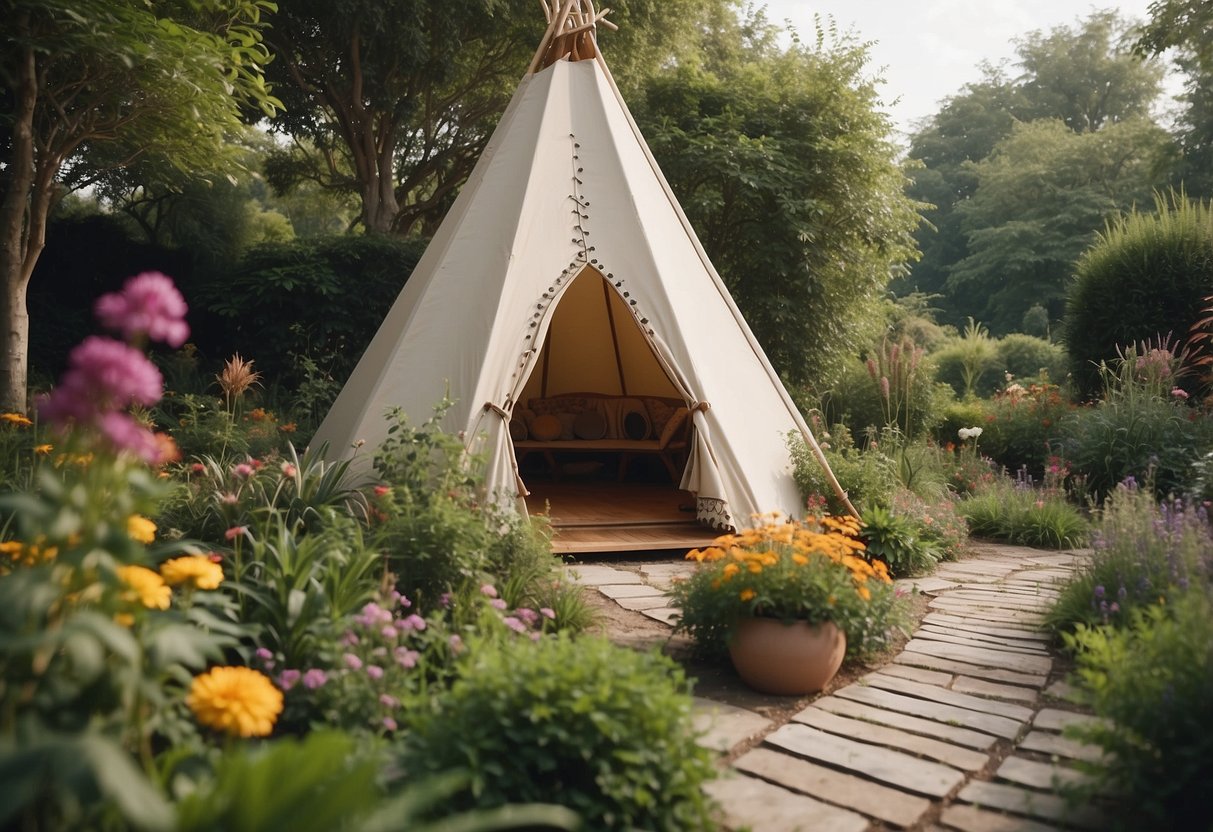
Are you eager to find simple yet effective ways to support climbing plants while adding vertical interest to your garden? Teepee garden structures are an excellent solution. They are easy to build and can be made from various materials like bamboo, branches, or metal poles. Dive into the world of teepee garden ideas and discover how these structures can transform your gardening experience!
1) Colorful Fabric DIY Teepee
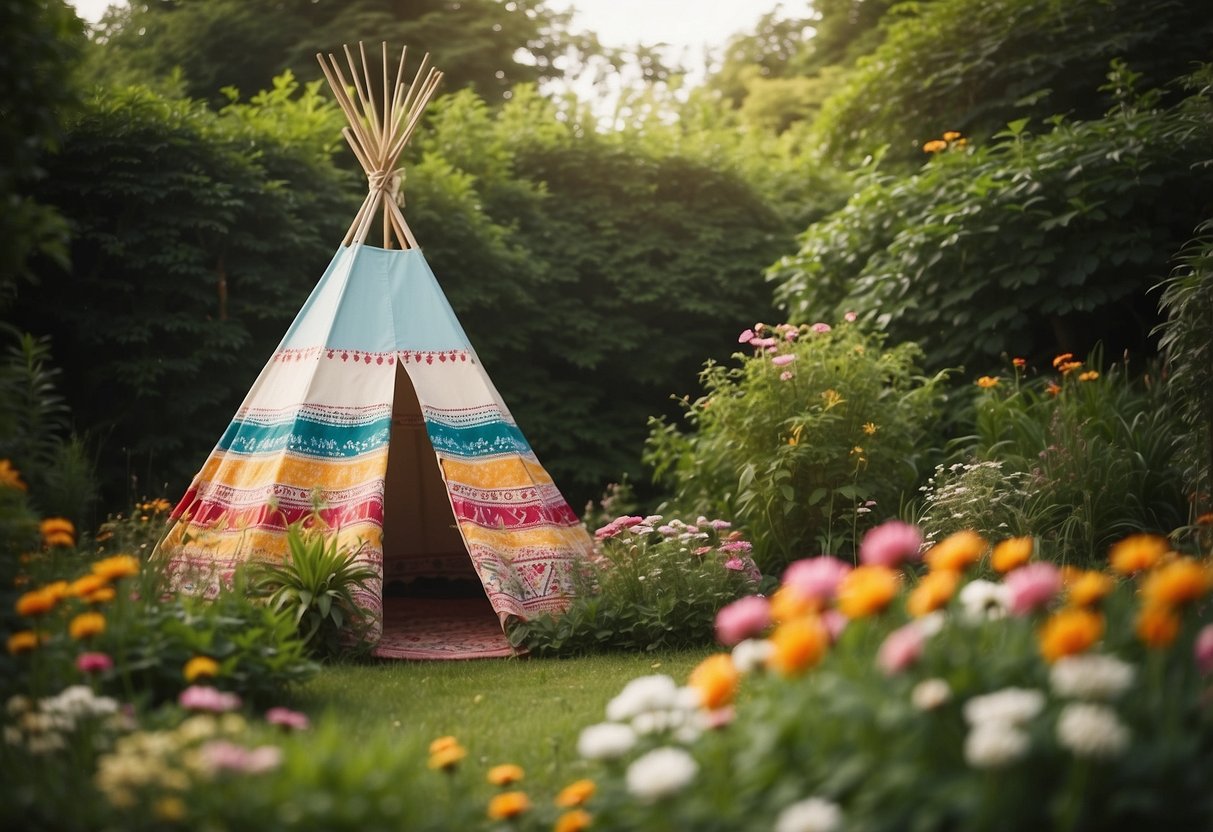
Creating a colorful fabric DIY teepee is a fun way to brighten up your garden. You and your kids can add fringe or pom-poms to the edges to make it unique. Paint colorful shapes or douse it in sparkles for a whimsical touch.
The DIY teepee can even be moved indoors when the weather is cooler. Use thrifted flat sheets to wrap around the poles. Attach the fabric with glue instead of stitches to keep it simple. An added bonus: string lights at the top create a cozy atmosphere in the evening.
For more inspiration, you can check out various patterns and ideas on Bob Vila’s site.
2) Hanging Fairy Lights
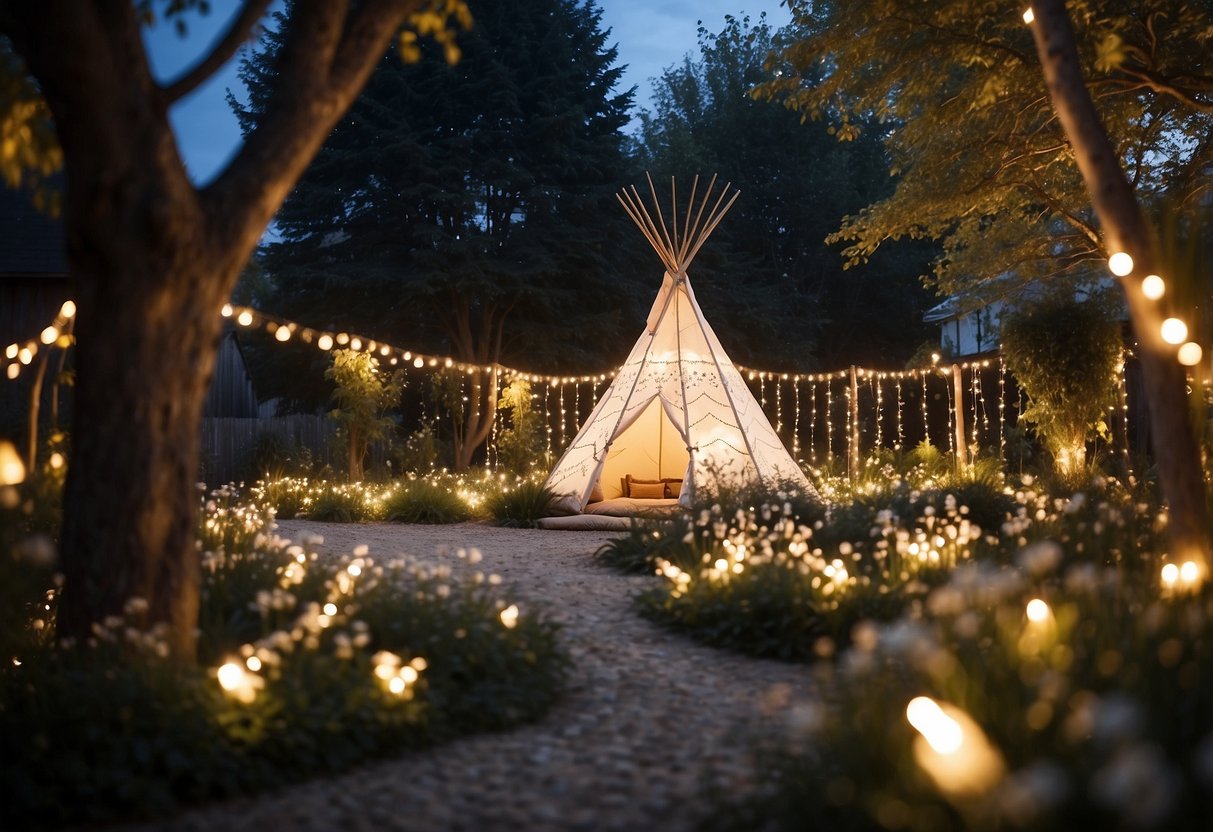
Hanging fairy lights can add a magical touch to your teepee garden.
Consider using solar-powered fairy lights. They charge during the day and light up at night, creating a beautiful glow.
Drape lights along the teepee frame or hang them from nearby trees for a whimsical effect.
Use colorful bulbs to add a playful vibe or stick with white for a classic look. Check out these outdoor fairy lights ideas for inspiration.
3) Cushioned floor seating
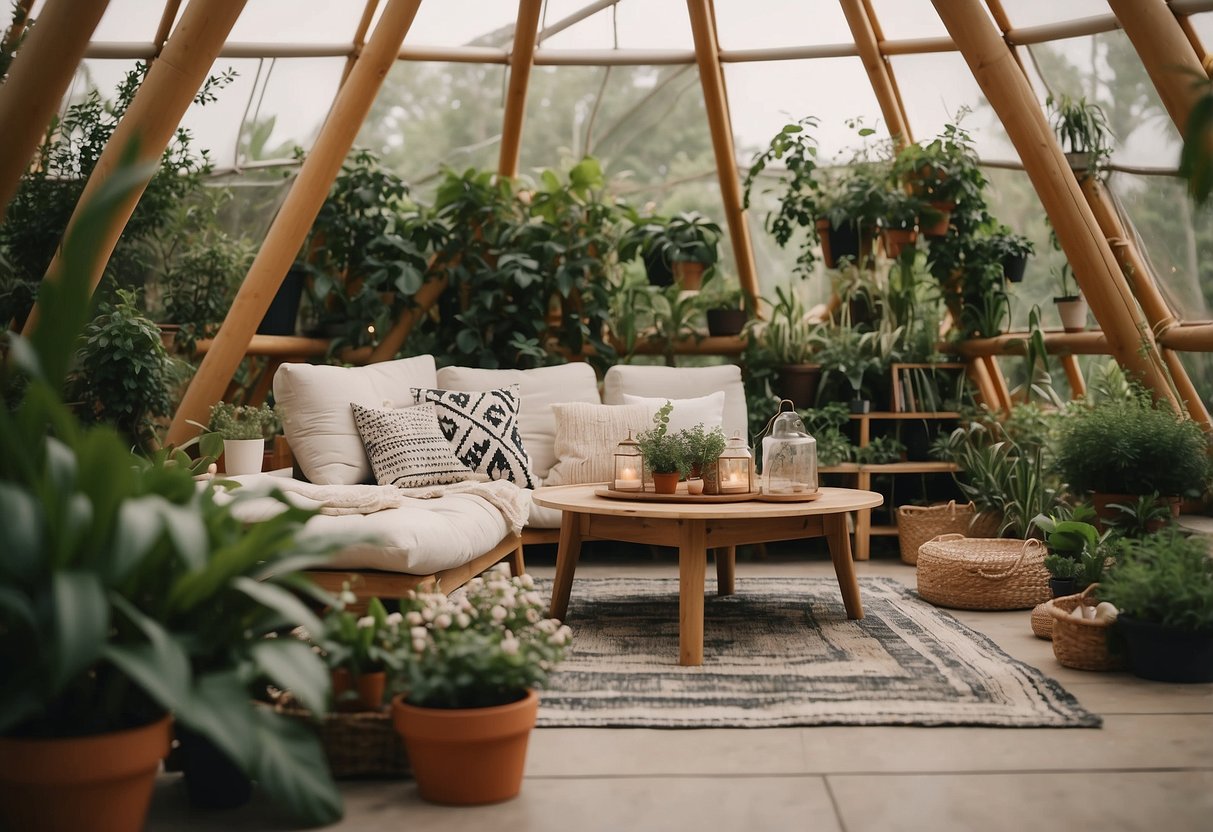
Cushioned floor seating is a great idea for your teepee garden. It makes the space cozy and comfortable for everyone. You can use large floor pillows or poufs to create a relaxing spot to sit.
Look for options like teepee floor cushions, which are available on Etsy. They add both comfort and style to your garden setup. It’s perfect for reading, lounging, or just enjoying the outdoors.
4) Planting flower borders

Planting flower borders can add color and charm to your teepee garden. Choose a mix of flowers that bloom at different times to keep your garden vibrant throughout the year.
Consider the sunlight your garden gets. If you have a sunny spot, go for sun-loving plants. For shaded areas, pick flowers that thrive without much direct sunlight.
Selecting flowers of varied heights creates an appealing layered look. Tall plants at the back and shorter ones at the front provide depth and interest.
For more tips, visit Better Homes & Gardens.
5) Outdoor Wind Chimes

Outdoor wind chimes add a touch of magic to your garden. The gentle sounds they create can make your space feel more peaceful and relaxing. You can choose from many DIY ideas, like making a macrame wind chime for a modern boho vibe.
Another idea is to create a sea glass and pebbles wind chime. Gather your own sea glass and pebbles to make it unique. If you want something simple, try using flexible twigs to create a basic wind chime that still looks great.
6) Vintage lanterns

Vintage lanterns add a cozy, nostalgic touch to your teepee garden. You can hang them from tree branches or place them along pathways.
These lanterns provide a warm, inviting glow in the evenings. They can be found at antique shops or even purchased as battery-operated versions for convenience.
Incorporating vintage lanterns can make your teepee garden feel magical. The aged look adds character and charm, creating a unique atmosphere.
7) Macrame decor

Macrame decor is a beautiful way to add a bohemian touch to your garden teepee. The intricate designs create an elegant look and feel.
You can make a macrame teepee using macrame cord and wooden rods. This adds a cozy and stylish element to your outdoor space.
Macrame decorations like hanging planters and wall hangings can complement your teepee. They bring in texture and charm.
For inspiration, explore these unique macrame teepee ideas. It’s perfect for garden parties and relaxing afternoons.
8) Bamboo Poles for Structure

Bamboo poles are a fantastic option for building a sturdy teepee garden. They are strong yet lightweight, making them easy to work with.
You can create a simple structure by binding the tops of the poles together with twine. This forms a stable frame for your climbing plants.
For more detailed instructions, visit build a bamboo trellis for vining veggies.
9) Handcrafted Dreamcatcher

Adding a handcrafted dreamcatcher to your garden teepee brings a touch of whimsy and charm. You can make one using a simple hoop, some yarn, and a few feathers.
First, wrap the hoop with yarn. Next, create the web inside by looping and knotting the yarn. Finally, attach some feathers and beads to complete the look.
A dreamcatcher swaying in the breeze adds a magical, bohemian feel to your outdoor space. For more ideas on making dreamcatchers, you can check out these DIY dreamcatcher patterns and instructions.
10) Stone Pathways

Stone pathways can add a lovely touch to your teepee garden. They provide a clear route to walk on and bring a natural, rustic feel.
You can choose from a variety of stones, like flagstones or pebbles. Irregularly shaped stones can create a whimsical look. Adding a pebble border can also enhance the aesthetic of your garden path.
Imagine walking on a flagstone pathway through lush greenery. These pathways are practical and beautiful, making your garden more enjoyable.
Understanding Teepee Gardens

Teepee gardens are unique and practical additions to your outdoor space. They offer both an attractive structure and functional support for growing various plants.
History of Teepee Gardens
Teepee gardens have roots in traditional agricultural practices. Indigenous people in North America used similar structures to grow climbing plants like beans. These teepees provided support for the vines and allowed for better air circulation around the plants.
Early settlers adapted this method for their gardens, appreciating how efficient and simple it was. Today, garden enthusiasts continue this tradition, building teepees from materials like bamboo, wood, or even metal poles.
Benefits of Teepee Gardens
Teepee gardens are excellent for vertical gardening. They save space in your garden and can make small areas more productive. Vegetables like beans, peas, and cucumbers thrive on these structures.
One of the main advantages is that they are easy to build. You only need a few sturdy poles and some twine or rope to lash them together. Teepee gardens also provide a natural play area for children, who can enjoy the hideaway formed by the climbing plants. Plus, the vertical growth helps with pest management and allows for easier harvesting.
Teepee gardens can also enhance the look of your garden. They add height and architectural interest, making your green space more dynamic and attractive.
Designing Your Teepee Garden
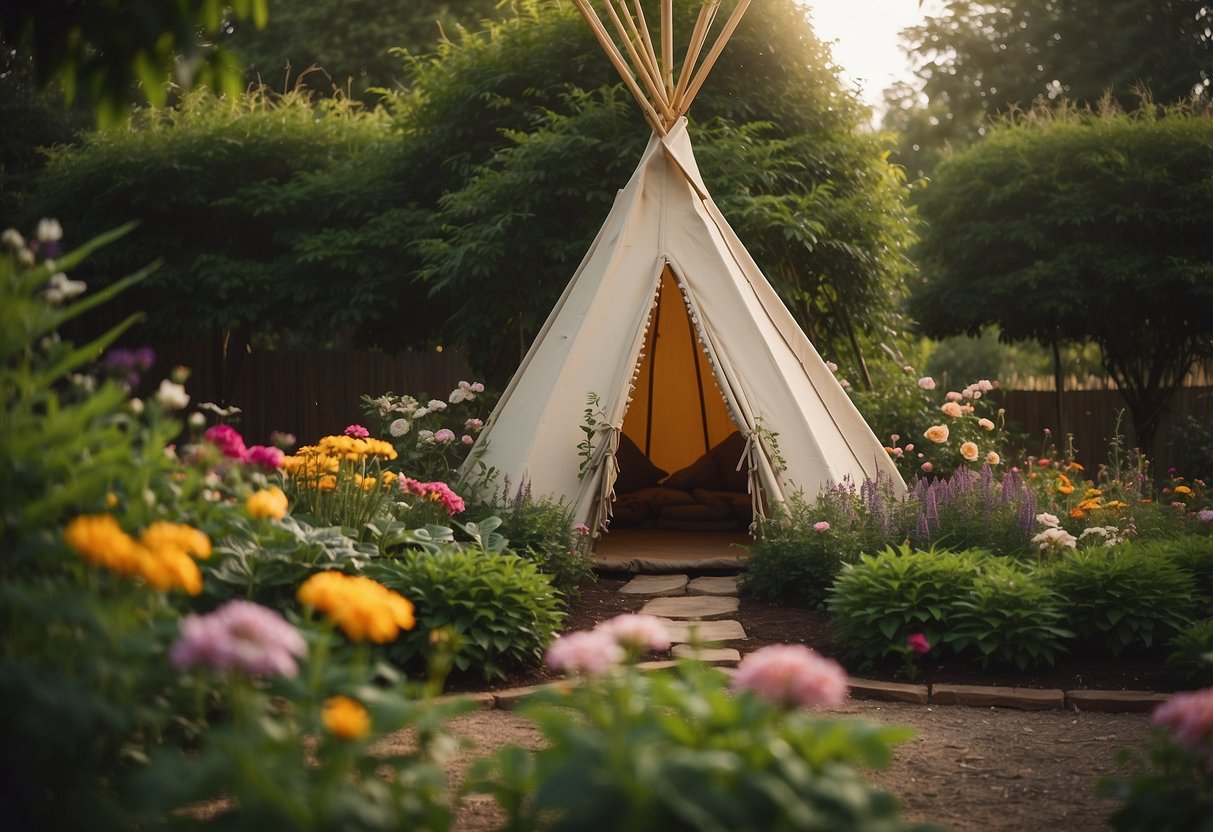
Creating a teepee garden involves selecting suitable plants, using the right materials for construction, and considering the seasonal requirements of your garden.
Choosing the Right Plants
Selecting the right plants for your teepee garden is important for its success. Beans and peas are great options because they climb naturally and thrive with the vertical structure. Other good choices include cucumbers and nasturtiums, which also benefit from the support of a teepee.
Bear in mind the climate and soil conditions in your garden. Plants like tomatoes need plenty of sunlight and well-drained soil. Make sure to evaluate these factors to ensure a healthy plant growth. Additionally, consider planting flowers like morning glories for a colorful and inviting look.
Teepee Structures and Materials
To build a garden teepee, you can use many different materials. Bamboo stakes are popular due to their strength and natural look. You can also use wooden poles or even sturdy branches for a more rustic feel. Ensure the poles are long enough to support the plants as they grow.
Use garden twine to tie the poles together at the top. Creating a teepee trellis helps maximize space and provides a strong framework. If you want to make a simpler structure, consider building a lean-to style teepee against a fence or wall for added support and stability.
Seasonal Considerations
Pay attention to seasonal changes when planning your teepee garden. Planting should align with the best growing seasons for your chosen plants. For example, peas are best sown in the early spring, while beans do better when planted in the late spring or early summer.
In colder climates, make sure to protect your plants from frost. Using mulch or covering your teepee with a garden fabric can help insulate and protect young plants. Always check the average frost dates in your region to time your planting correctly and ensure your garden thrives throughout the growing season.
Remember that some plants need specific watering schedules and care routines based on the season, so keep a garden journal to monitor their progress and make necessary adjustments.







